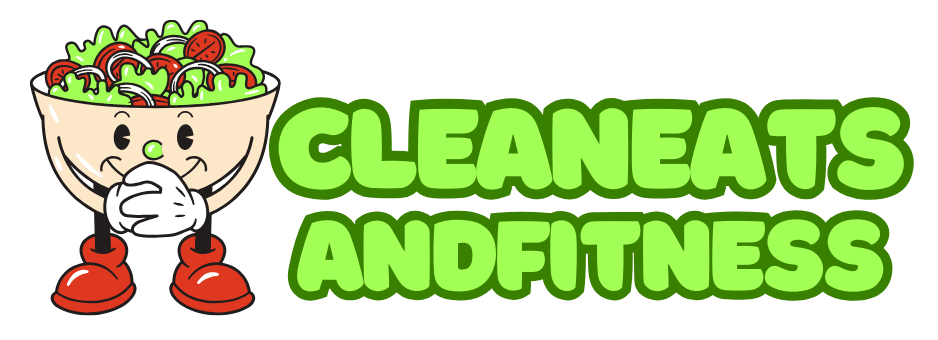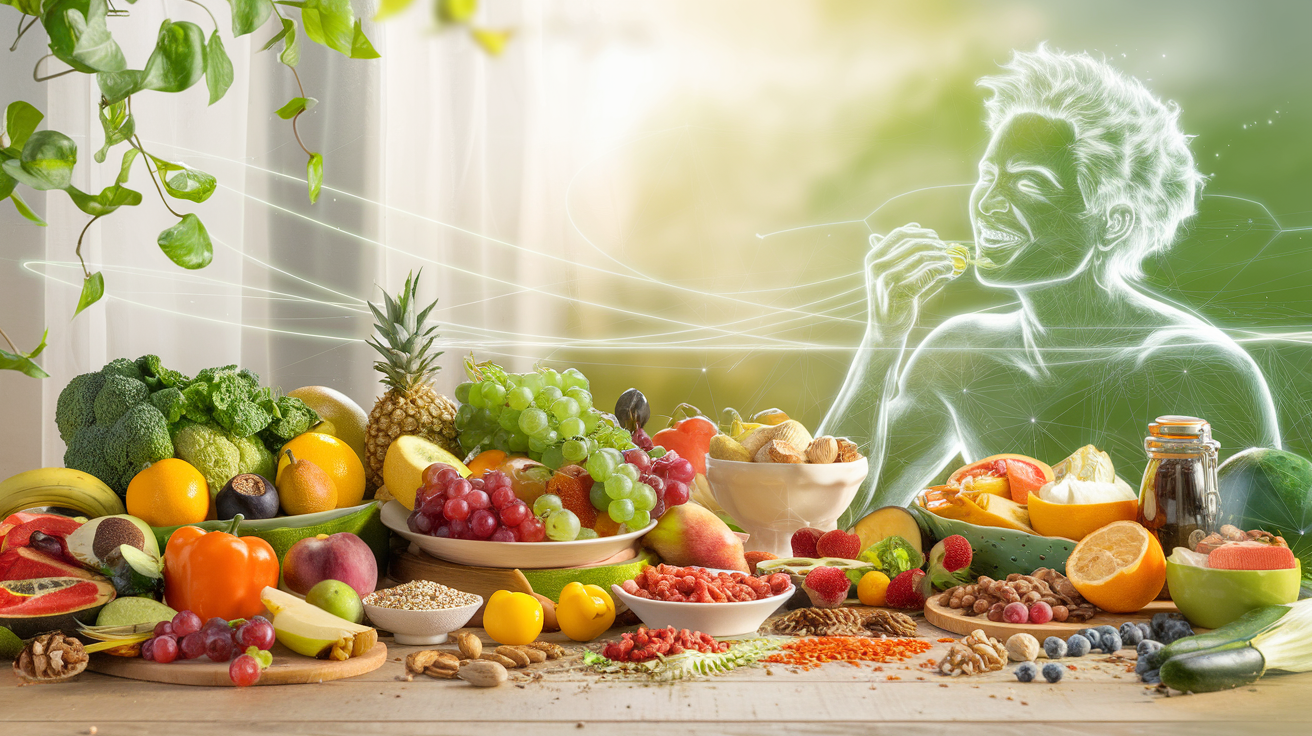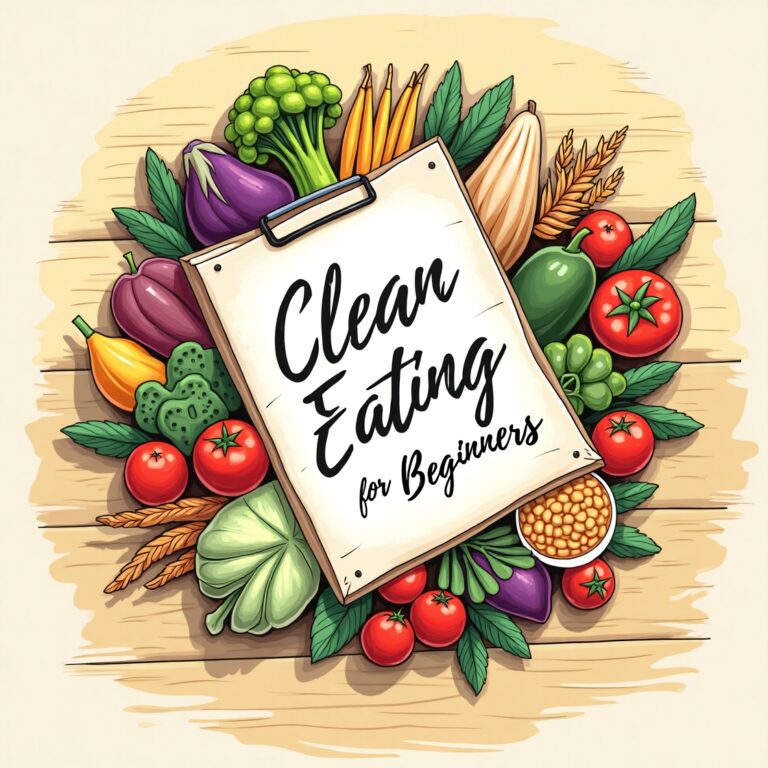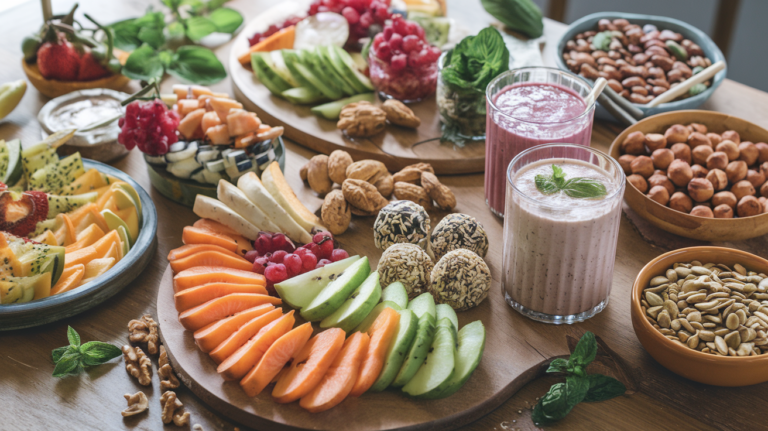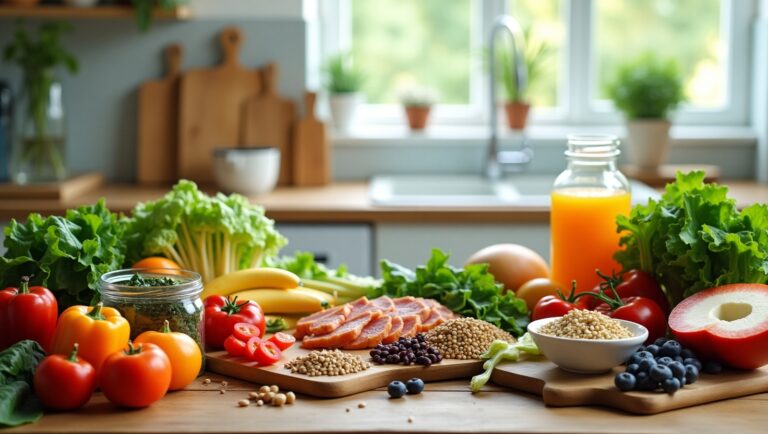Clean Eating Benefits & Transformation Tips for Health
Have you thought about how food choices affect your health? Clean eating not only makes your body better but also changes how you see health. It makes your life better in ways you might not expect.
In this guide, you’ll learn about clean eating’s many health benefits. You’ll get tips to help you eat healthier and live better. You’ll also find out how to make nutritious recipes that boost your health.
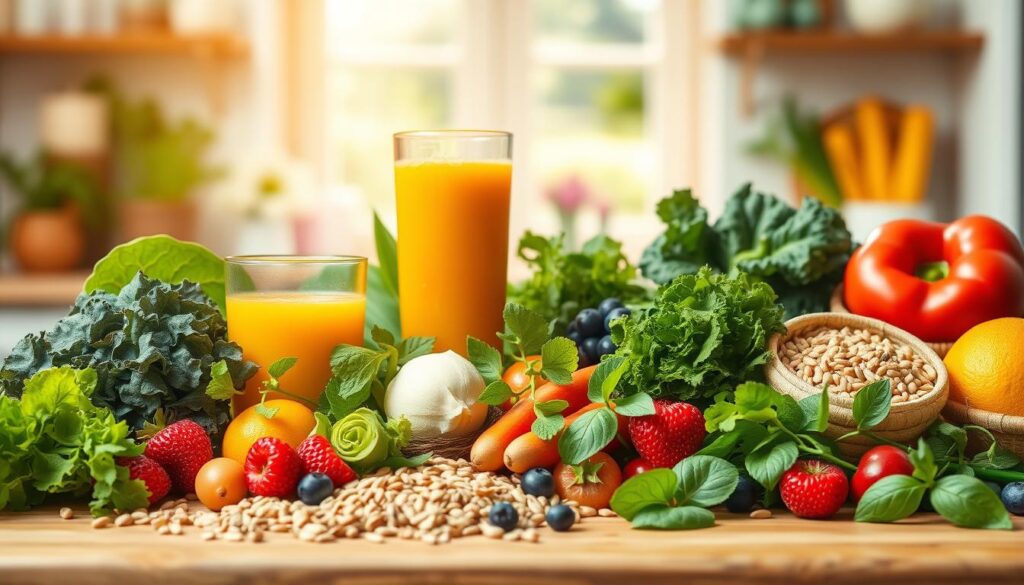
Key Takeaways
- Clean eating focuses on whole, unprocessed foods.
- Embracing clean eating can enhance your immune system.
- Understanding caloric deficit is key for weight loss.
- Building healthy eating habits takes commitment and practice.
- Meal prepping simplifies the clean eating process.
- Reading nutrition labels is essential for making informed choices.
Understanding Clean Eating
Clean eating means making smart food choices for better health. It’s about eating foods in their natural form. This includes fresh fruits, veggies, lean proteins, whole grains, and healthy fats.
Stay away from processed foods and artificial additives. Following these rules helps you eat cleaner and support your body’s health.
The quality of your food matters a lot in clean eating. Choose foods that boost your energy and health. Eating fresh foods gives you the nutrients you need.
It also helps with digestion and makes you feel more alive. This way, you can start eating healthier and reach your wellness goals.
Benefits of Clean Eating for Health
Clean eating is good for your health. It helps your immune system and makes you feel better. Eating whole foods gives your body the vitamins and minerals it needs.
How Clean Eating Supports Your Immune System
Clean eating makes your immune system stronger. Foods like fruits, veggies, nuts, and seeds have antioxidants and vitamins. They help your body fight off sickness.
Eating foods with vitamin C, like oranges, and vitamin E, like almonds, helps too. This way, you can stay healthy and avoid getting sick often.
The Role of Nutrient-Dense Foods in Health
Nutrient-dense foods are key to a healthy diet. They have lots of nutrients but fewer calories. Foods like quinoa, salmon, and leafy greens are tasty and give you energy.
By eating these foods, you help your body work well. You get the energy you need to stay active and healthy.
Clean Eating for Weight Loss
Starting a clean eating plan is key to managing your weight. It means eating whole foods that are not heavily processed. This helps you eat fewer calories without feeling hungry.
By choosing foods that are full of nutrients, you avoid empty calories. These calories can slow down your weight loss. Clean eating makes it easier to eat well and feel good.
Understanding Caloric Deficit Through Clean Eating
To lose weight, you need to eat fewer calories. Clean eating helps you eat more fiber and protein. These foods make you feel full and have fewer calories than processed foods.
Learning about portion sizes gets easier when you focus on quality food. This way, you can enjoy your meals and snacks. It helps you make choices that help you lose weight.
Impact of Clean Eating on Metabolism
Clean eating boosts your metabolism. It focuses on foods that are full of vitamins and minerals. These foods help your body work well.
Protein takes more energy to digest, which burns more calories. Eating whole foods helps your metabolism stay healthy. This makes it easier to lose weight.
Essential Clean Eating Tips
Starting your clean eating journey can feel like a big task. To make it easier, use practical advice. This will help you start right and keep going.
How to Start Your Clean Eating Journey
Starting your clean eating journey needs careful planning. Here are some tips to help:
- Stock your kitchen with whole foods like fruits, veggies, lean proteins, and whole grains.
- Meal prep at the start of each week to avoid unhealthy choices.
- Stay hydrated by drinking lots of water all day.
- Educate yourself on what’s in food labels to make smart choices.
Common Mistakes to Avoid
Many people make mistakes in their clean eating journey. Knowing these can help you stay on track:
- Too much of “clean” processed foods can be unhealthy.
- Not watching portion sizes can lead to eating too much.
- Not planning for eating out can mess up your clean eating.
- Being too strict can cause burnout and unhealthy eating.
Creating a Clean Eating Meal Plan
Creating a clean eating meal plan is key to reaching your health goals. It helps you eat a variety of foods and balance your diet. This guide will show you how to use seasonal produce and leftovers in your meal prep.
Structuring Your Weekly Meals
Start by making a meal plan for the week. Include fruits, veggies, whole grains, and lean proteins. Here’s a sample plan:
| Day | Breakfast | Lunch | Dinner | Snacks |
|---|---|---|---|---|
| Monday | Oatmeal with berries | Quinoa salad with chickpeas | Grilled chicken with vegetables | Mixed nuts |
| Tuesday | Greek yogurt with honey | Lentil soup | Salmon with brown rice | Carrot sticks |
| Wednesday | Scrambled eggs with spinach | Turkey wrap | Stir-fried tofu with broccoli | Apple slices |
| Thursday | Smoothie with banana and spinach | Chickpea salad | Beef stir-fry with veggies | Rice cakes |
| Friday | Avocado toast | Vegetable sushi | Pasta with marinara sauce | Dark chocolate |
| Saturday | Protein pancakes | Caprese salad | Baked tilapia with quinoa | Popcorn |
| Sunday | Chia seed pudding | Grilled vegetable sandwich | Homemade chili | Yogurt |
Balancing Macronutrients in Your Diet
To balance your diet, aim for 40% carbs, 30% protein, and 30% fats. Adjust these based on your activity level. For example, more active people might need more carbs.
Use healthy fats like olive oil or avocados for flavor. Sticking to your meal plan helps your health in the long run.
Simple Clean Eating Recipes
Embracing clean eating doesn’t mean you have to give up taste. You can make delicious meals that are also good for you. Here are some easy clean eating recipes to add to your daily meals. They use healthy ingredients and are quick to make.
Start your day with a refreshing smoothie. Mix spinach, banana, almond milk, and almond butter. It’s a great way to get nutrients and energy.
For lunch, try a quinoa salad. Mix cooked quinoa with cucumbers, tomatoes, chickpeas, and olive oil. Add lemon juice and herbs for flavor. It’s a protein-packed dish with different textures.
Roasted chickpeas make a great snack. Toss chickpeas with olive oil and spices like paprika or garlic. Roast until crispy for a tasty, healthy snack.
End your day with baked salmon and steamed veggies. Season the salmon with herbs and bake until it’s flaky. Serve with broccoli or asparagus for extra nutrients. It’s a healthy dinner option.
Trying out these healthy meal ideas can make cooking fun. Clean eating is not just about healthy food. It’s also about meals that make you feel good.
Clean Eating Transformation Tips
Changing how you eat takes effort and smart plans. Keeping up your motivation is key. Set goals that fit your life to feel more confident.
Write down your progress or use apps. Seeing your growth helps you stay on track.
Tips for Staying Motivated
- Set specific, measurable, and attainable goals.
- Keep a visual reminder of your motivations, such as photos or quotes.
- Celebrate small victories to stay encouraged.
- Join a community or find a buddy for accountability.
Benefits of Meal Prepping
Meal prepping is a big help in your clean eating journey. It saves time on busy days and stops unhealthy snacks. With meals ready, you stick to your clean eating plan.
Building Healthy Eating Habits
Building healthy eating habits is key for a lifestyle change. It starts with understanding your hunger cues and eating mindfully. This way, you can listen to your body and make healthy choices.
Add lean proteins, whole grains, and healthy fats to your meals. These foods give you energy and help you eat well. Here are some tips:
- Plan your meals ahead of time to avoid bad choices.
- Keep healthy snacks on hand to stop cravings.
- Use small plates and bowls for portion control.
- Eat slowly and enjoy each bite.
These habits help you eat better and enjoy your food more. By focusing on healthy eating, you can feel better and love food more.
Clean Eating Grocery List Essentials
Starting a clean eating journey needs a good grocery list. Focus on whole foods for meals that are good for you. This part talks about making a clean eating list and reading labels well.
Choosing Whole Foods Over Processed Ones
Make your list full of whole foods. These are fruits, veggies, whole grains, lean proteins, and healthy fats. They are good for you because they are not processed much.
Try to eat different colors of fruits and veggies. This way, you get lots of nutrients.
- Fresh fruits such as berries, apples, and oranges
- Leafy greens like spinach and kale
- Whole grains such as quinoa, brown rice, and oatmeal
- Lean proteins including chicken breast, fish, tofu, and legumes
- Healthy fats like avocados, nuts, and olive oil
Reading Nutrition Labels Effectively
Learning to read labels well helps you make smart choices. Look at serving sizes, ingredient lists, and nutrients. Choose items with fewer ingredients for less processing.
Look for products with at least 3 grams of fiber per serving and low in added sugars.
| Label Component | What to Look For |
|---|---|
| Ingredients | Choose products with whole food ingredients. |
| Sugars | Aim for products with low or no added sugars. |
| Fiber | Look for at least 3g of fiber per serving. |
| Fats | Favor healthy fats over saturated and trans fats. |
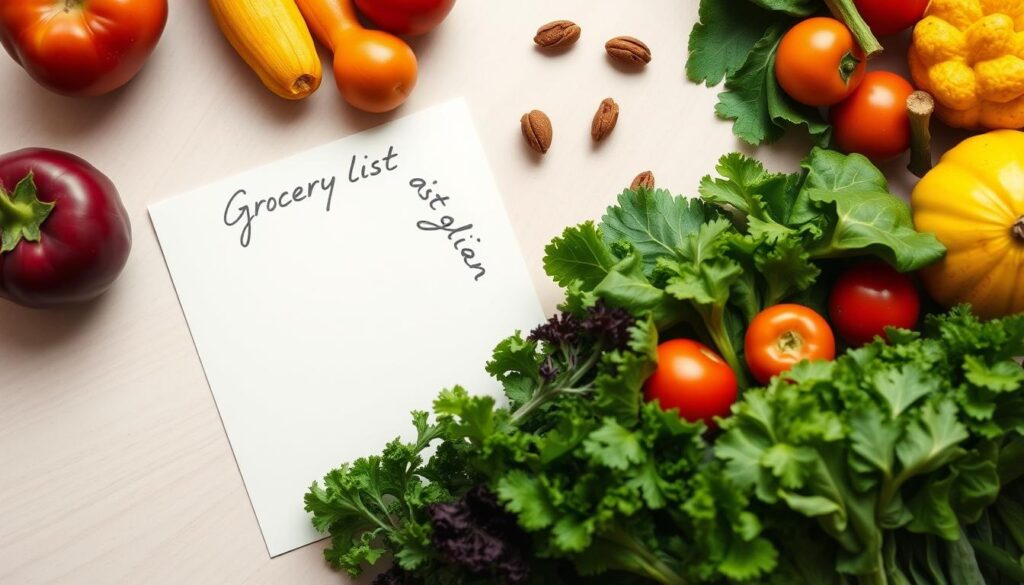
How Clean Eating Influences Mental Health
Clean eating is good for your body and mind. It shows how food affects your feelings and thinking. Eating foods that are good for your brain can really help your mental health.
Connection Between Diet and Mood
Your diet can change how you feel. It can make you feel anxious or happy. Eating foods full of nutrients helps keep your mood steady.
By eating clean, you choose foods that are good for your feelings. This helps you feel better emotionally.
Foods That Boost Brain Function
Some foods are great for your brain. They make you think clearer and feel less stressed. Here are some:
- Omega-3 fatty acids found in fish like salmon and walnuts
- Whole grains such as quinoa and brown rice that provide steady energy
- Colorful fruits and vegetables, which are packed with antioxidants
Choosing these foods helps your brain and mind. It makes you feel better and think clearer.
Benefits of Clean Eating for Disease Prevention
Eating clean is key to staying healthy. It means choosing foods that are whole and not processed. This helps avoid many health problems linked to bad eating.
Heart disease, diabetes, and some cancers are often caused by unhealthy food. Eating more fruits, veggies, whole grains, and lean proteins helps manage these diseases well.
Antioxidant foods fight inflammation and stress, which harm our health. Berries, leafy greens, nuts, and seeds are full of vitamins. They boost our immune system and make us healthier.
Clean eating also teaches us to know what we eat. This knowledge helps us make better food choices. It leads to a healthier lifestyle and fights chronic diseases.
Transforming Your Mindset Around Food
Changing how you think about food is key to lasting clean eating. Building a positive food relationship can change your eating and feelings. Knowing what makes you eat emotionally is a big step.
By understanding your emotional food choices, you can break down mental blocks. This helps you move forward.
Start a healthier mindset by being mindful while eating. This lets you enjoy your food without feeling bad. Also, keep a journal to see when you eat because of emotions. This can show patterns and what makes you eat emotionally.
Try to see food in a new light. Instead of thinking some foods are bad, believe all can be part of a good diet. This view helps you feel better about all food choices.
With regular effort and kindness to yourself, you can have a better food relationship. Focus on your emotional health as much as your nutrition. This builds a strong base for lasting change.

How to Overcome Cravings and Temptations
Cravings and food temptations can be tough to beat. Finding out what makes you crave food is key. Things like stress, boredom, and ads can trigger these feelings.
Having healthy snacks ready is a big help. Fill your pantry with fruits, nuts, and yogurt. This way, you can choose better food instead of junk.
Mindful eating is also important. Pay attention to your food, enjoy each bite, and know when you’re full. This helps you avoid giving in to cravings.
It’s okay to have treats sometimes. This keeps your diet balanced and stops you from feeling deprived. Enjoying treats in a mindful way helps you stay on track.
Conclusion
This clean eating summary shows many benefits beyond just food. It talks about how clean eating helps your health in many ways. It boosts your immunity, helps with weight, and makes you feel better mentally.
Eating foods that are full of nutrients helps you reach your goals. It also makes you feel good inside.
This article gave you tips for starting a clean eating plan. It also warned about common mistakes. You now know how important it is to eat healthy foods.
By following the advice in this guide, you can make eating healthier a habit. Remember, clean eating is a journey. It makes you feel better and more alive.
FAQ
What are the main benefits of clean eating for health?
Clean eating boosts your energy and strengthens your immune system. It also improves digestion and lowers the risk of chronic diseases. Eating whole foods gives your body the nutrients it needs for health and energy.
How can I start my clean eating transformation?
Start by learning about clean eating. Add fresh fruits, veggies, lean proteins, whole grains, and healthy fats to your meals. Meal prep helps too, keeping you away from processed foods.
Are there any clean eating tips for busy individuals?
Yes! For a busy life, prep meals on weekends and keep a stocked kitchen. Easy, healthy recipes help you eat well even when you’re busy.
What can I include in my clean eating grocery list?
Your list should have fresh fruits and veggies, whole grains, lean proteins, and healthy fats. Don’t forget spices to add flavor without additives.
How does clean eating aid in weight loss?
Clean eating helps you lose weight by eating foods that are full of nutrients but low in calories. Whole foods are often less calorie-dense but more filling, making it easier to manage your weight.
What are some common mistakes to avoid while adopting a clean eating lifestyle?
Avoid using “clean” processed foods instead of whole foods. Don’t forget about portion control and meal planning. Choose real foods and watch your portion sizes for the best results.
How can I maintain motivation during my clean eating journey?
Stay motivated by setting achievable goals and tracking your progress. Join supportive groups, try new recipes, and celebrate your successes to keep your enthusiasm up.
What is the connection between clean eating and mental health?
Diet affects mood. Clean eating gives your brain the nutrients it needs, like omega-3s and vitamins. A balanced diet can improve your mood, reduce anxiety, and enhance brain function.
What are some simple clean eating recipes I can try?
Try quinoa salads, baked salmon, overnight oats, and green smoothies. These recipes are easy to make and follow clean eating principles, perfect for your diet change.
How does meal prepping benefit clean eating?
Meal prepping saves time and reduces waste. It ensures you have healthy food ready, making it easier to avoid unhealthy choices when you’re hungry.
What are the health benefits of clean eating for preventing diseases?
Clean eating lowers the risk of heart disease, diabetes, and some cancers. It gives your body the nutrients it needs to fight off illness and stay healthy.
